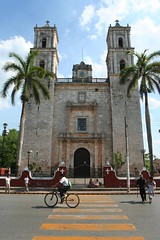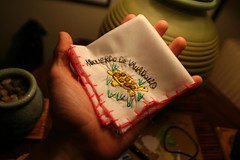The dank but cool, morning air in New York was replaced by 90ºF at 150% humidity in San Salvador. With time to kill, we sauntered aimlessly up and down the terminal. I entertained myself on the moving sidewalks, while Tim looked the other way. Eventually we settled down in a couple barstools at a place creatively named "The Bar". The atmosphere was just right though. We each ordered a couple beers of different kinds, and I enjoyed a little Spanish banter with the bartender. We then gaped at the ridiculous Spanish music videos playing on the small TVs flanking the bar. From the corner of my eye, I observed another pale-skinned traveller as he dissected his sandwich which, once properly dismantled, he abandoned disgruntled. Let's call him Hansel. We were at last in Latin America. Beers: $3US each.
[05/09/08]
During the second leg of our flight, we found ourselves seated next to someone positively more outgoing than Hansel. Marisol was originally from Peru, returning from her new life in Ontario for a baby shower. She was in-the-know, and dying to share her experience. Tim and I took notes on every word she said like we were at a review session for a test. Advice was dispensed on hiking to Machu Picchu, how to deal with "culebras" (snakes), and what it is meant by "las cejas de la selva" (the eyebrows of the jungle) - this refers to the climate where Machu Picchu is located. We learned that if we ask the locals how far a place is by foot, we're likely to receive the response "aqui, no mas" (not much further from here) even if the destination in question is 2 hours hike uphill. Andeans simply have a different concept of walking time. She taught is that the Sacred Valley is carved out by the Urubamba River, and suggested that we continue from Machu Picchu on to visit Ollantaytambo and Pisac by way of train from Aguas Calientes then bus from "Ollanta."
When she found out that Tim and I would be trapped at Lima International for the duration of the night, Marisol offered to set us up with a ride in and out of Lima for dinner. We met her grandmother's chauffeur at the airport, and were whisked away in a beat up station wagon to Miraflores. Once on the road, Marisol seemed like she might have spontaneously combusted at any moment. Somehow she was capable of catching up with the chauffer, talking about the baby shower to family and friends on her cell phone, and giving Tim and I the history of every district we passed through. She shifted in her chair every 3 seconds pointing out incredibly overcrowded busses, poorly constructed buildings, and practically lawless traffic patterns. We passed through the ghetto and a lower-middle class area to find ourselves following a road along the beach. Windows down, she put her head and shoulders out the window, cherishing each breath of the rank, smog-saturated air like it was pure oxygen. Tim and I lay slouched in the back seat alternating between breathing through our clothes and holding our breath. "Wow. So this is what home smells like... Super." Next time I find myself nostalgic for Lima, I'll start a bonfire on the beach, making sure to use leaded gasoline and tires as fuel. "Mmmmm, smell that fellas, that right there is the urban Pacific coast of Peru."
Eventually the stench of smog did begin to decrease and the infrastructure became increasingly modern. Miraflores was quite beautiful, probably moreso during the daytime, but at least we were cool at night. Marisol took us to a park at the top of some massive cliffs overlooking the ocean where Tim and I looked down to find that they had built a mall right into the ledge. The place, called Larcomar, was quite beauitful and filled with everything from restaurants, to night clubs, to stores, and even a bowling alley. Inside (though it was all open to the air) Marisol showed is a really nice seafood restaurant called Mango's. She spoke with the hostess about arranging us a ride back to the airport and a place to keep our bags in case we wanted to explore the area a bit. Amazing! They set us up with a nice table outside overlooking the Pacific and we said ourgoodbyes to Marisol after getting her contact info. "In case you need anything," she said. What more could we expect?
We sat down and ordered what she had suggested: Piqueo Marino (un caliente, un frio), and to drink Pisco Sour y Maracuya Sour. This turned out to be a massive amount of food, but it worked out to be only S/.103 or $47US. Our waiter Juan showed us where we could keep our bags safe after he indulged my craving for more Spanish conversation. I told him about our hiking plans and his eyes lit up when I mentioned Machu Picchu. How many people here, I wondered, would get to see Machu Picchu in their lifetime? One thing was for sure, the Peruvians took pride in their Machu Picchu the way other countries cheriesh their wonders.
Tim and I walked around outside the mall a bit, but returned to Mango's before long to have them call us a safe taxi. I tipped Juan and tanked them all profusely for their outstanding service before leaving. A sharp looking guy dressed in a suit came in before long and introduced himself as Jorge. Our taxi was waiting outside. Compared to the the last vehicle we had ridden in Jorge's ride was more like a limousine, some sort of shiny, black, luxury SUV. Jorge was great too, he entertained us with interesting half-English, half-Spanish conversation the whole 25 minute ride back to the airport. We parted ways with Jorge happily... $25 for the ride, $5 for tip.
As an interesting aside, we've learned that the U.S. presidential elections are not just fair grounds for conversation in the U.S. Both Jorge and Marisol brought it up in fact. Marisol saying that her grandmother thinks other countries should get to vote for our president. I might agree considering our track record with foreign relations.
Ahora, estamos en el aeropuerto. Es manana hoy... y estamos cansados y confundado a la hora. Están otras personas como nosotros, durmiendo cerca de sus mochilas en el piso del aeropuerto. Me duele la cabeza, pero manana (hoy) vamos a Cuzco, y no tenemos razon de dolor.
Ahora, estamos en el aeropuerto. Es manana hoy... y estamos cansados y confundado a la hora. Están otras personas como nosotros, durmiendo cerca de sus mochilas en el piso del aeropuerto. Me duele la cabeza, pero manana (hoy) vamos a Cuzco, y no tenemos razon de dolor.




